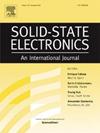量子点敏化太阳能电池用Cu2ZnSnS4-Cu9S5异质结对电极
IF 1.4
4区 物理与天体物理
Q3 ENGINEERING, ELECTRICAL & ELECTRONIC
引用次数: 0
摘要
对电极(CEs)是量子点敏化太阳能电池(QDSSCs)中收集外电路电子和催化还原电解质的关键部件。因此,研究具有梯度势能的异质结ce对QDSSCs的电荷输运有积极的影响。本文设计了Cu2ZnSnS4-Cu9S5异质结作为CdS/CdSe量子点QDSSCs的CE,并制作了Cu9S5 CE进行比较。与Cu9S5 CE相比,基于Cu2ZnSnS4-Cu9S5 CE的QDSSCs具有显著的短路电流密度(13.71 mA/cm2)和功率转换效率(3.27%)。电化学阻抗谱和Tafel极化结果表明,含有Cu2ZnSnS4-Cu9S5 CE的器件具有较低的串联电阻(7.23 Ω/cm2)和较高的极限电流密度值。这是由于Cu2ZnSnS4-Cu9S5异质结具有较高的催化活性和优越的电荷输运特性。因此,这项工作表明异质结ce在光电器件领域具有很大的潜力。本文章由计算机程序翻译,如有差异,请以英文原文为准。

Cu2ZnSnS4-Cu9S5 heterojunction counter electrode for quantum dot-sensitized solar cells
Counter electrodes (CEs) are key components for collecting external circuit electrons and catalyzing reduced electrolytes in quantum dot-sensitized solar cells (QDSSCs). Hence, inquiry into heterojunction CEs with gradient potential energy can positively impact the charge transport of QDSSCs. In this work, a Cu2ZnSnS4-Cu9S5 heterojunction was designed as the CE for QDSSCs with CdS/CdSe quantum dots, and a Cu9S5 CE was fabricated for comparison. Compared to the Cu9S5 CE, QDSSCs based on the Cu2ZnSnS4-Cu9S5 CE exhibited a significantly improved short-circuit current density (13.71 mA/cm2) and power conversion efficiency (3.27 %). The electrochemical impedance spectroscopy and Tafel polarization results revealed that the device containing the Cu2ZnSnS4-Cu9S5 CE had a lower series resistance of 7.23 Ω/cm2 and higher limiting current density values. This was attributed to the high catalytic activity and superior charge transport properties of the Cu2ZnSnS4-Cu9S5 heterojunction. Therefore, this work demonstrates that heterojunction CEs hold great potential in the field of optoelectronic devices.
求助全文
通过发布文献求助,成功后即可免费获取论文全文。
去求助
来源期刊

Solid-state Electronics
物理-工程:电子与电气
CiteScore
3.00
自引率
5.90%
发文量
212
审稿时长
3 months
期刊介绍:
It is the aim of this journal to bring together in one publication outstanding papers reporting new and original work in the following areas: (1) applications of solid-state physics and technology to electronics and optoelectronics, including theory and device design; (2) optical, electrical, morphological characterization techniques and parameter extraction of devices; (3) fabrication of semiconductor devices, and also device-related materials growth, measurement and evaluation; (4) the physics and modeling of submicron and nanoscale microelectronic and optoelectronic devices, including processing, measurement, and performance evaluation; (5) applications of numerical methods to the modeling and simulation of solid-state devices and processes; and (6) nanoscale electronic and optoelectronic devices, photovoltaics, sensors, and MEMS based on semiconductor and alternative electronic materials; (7) synthesis and electrooptical properties of materials for novel devices.
 求助内容:
求助内容: 应助结果提醒方式:
应助结果提醒方式:


